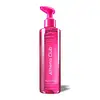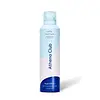What's inside
What's inside
 Key Ingredients
Key Ingredients

 Benefits
Benefits

 Concerns
Concerns

 Ingredients Side-by-side
Ingredients Side-by-side

Water
Skin ConditioningPolysorbate 20
EmulsifyingGlycereth-26
HumectantGlycerin
HumectantParfum
MaskingTheobroma Grandiflorum Seed Butter
Skin ConditioningSimmondsia Chinensis Seed Oil
EmollientPersea Gratissima Oil
Skin ConditioningHelianthus Annuus Seed Oil
EmollientButyrospermum Parkii Butter
Skin ConditioningPistacia Vera Seed Oil
Skin ConditioningArgania Spinosa Kernel Oil
EmollientPrunus Amygdalus Dulcis Oil
Skin ConditioningAllantoin
Skin ConditioningTocopherol
AntioxidantCocos Nucifera Oil
MaskingSodium Chloride
MaskingCaprylyl Glycol
EmollientPolyquaternium-10
Phenoxyethanol
PreservativeWater, Polysorbate 20, Glycereth-26, Glycerin, Parfum, Theobroma Grandiflorum Seed Butter, Simmondsia Chinensis Seed Oil, Persea Gratissima Oil, Helianthus Annuus Seed Oil, Butyrospermum Parkii Butter, Pistacia Vera Seed Oil, Argania Spinosa Kernel Oil, Prunus Amygdalus Dulcis Oil, Allantoin, Tocopherol, Cocos Nucifera Oil, Sodium Chloride, Caprylyl Glycol, Polyquaternium-10, Phenoxyethanol
Water
Skin ConditioningAloe Barbadensis Leaf Juice
Skin ConditioningPalmitic Acid
EmollientTriethanolamine
BufferingIsopentane
SolventLaureth-23
CleansingSorbitol
HumectantAvena Sativa Kernel Extract
AbrasiveStearic Acid
CleansingGlycerin
HumectantGlyceryl Oleate
EmollientAllantoin
Skin ConditioningHydroxypropylcellulose
EmulsifyingDisodium Phosphate
BufferingMyristic Acid
CleansingPolysorbate 60
EmulsifyingPotassium Sorbate
PreservativeSodium Phosphate
BufferingTitanium Dioxide
Cosmetic ColorantPhenoxyethanol
PreservativeIsobutane
Parfum
MaskingWater, Aloe Barbadensis Leaf Juice, Palmitic Acid, Triethanolamine, Isopentane, Laureth-23, Sorbitol, Avena Sativa Kernel Extract, Stearic Acid, Glycerin, Glyceryl Oleate, Allantoin, Hydroxypropylcellulose, Disodium Phosphate, Myristic Acid, Polysorbate 60, Potassium Sorbate, Sodium Phosphate, Titanium Dioxide, Phenoxyethanol, Isobutane, Parfum
Ingredients Explained
These ingredients are found in both products.
Ingredients higher up in an ingredient list are typically present in a larger amount.
Allantoin is a soothing ingredient known for its protective and moisturizingg properties. Because of this, it is often added to products with strong active ingredients.
Studies show higher concentrations of this ingredient can promote wound healing.
Though it can be derived from the comfrey plant, allantoin is produced synthetically for cosmetic products to ensure purity.
Learn more about AllantoinGlycerin is already naturally found in your skin. It helps moisturize and protect your skin.
A study from 2016 found glycerin to be more effective as a humectant than AHAs and hyaluronic acid.
As a humectant, it helps the skin stay hydrated by pulling moisture to your skin. The low molecular weight of glycerin allows it to pull moisture into the deeper layers of your skin.
Hydrated skin improves your skin barrier; Your skin barrier helps protect against irritants and bacteria.
Glycerin has also been found to have antimicrobial and antiviral properties. Due to these properties, glycerin is often used in wound and burn treatments.
In cosmetics, glycerin is usually derived from plants such as soybean or palm. However, it can also be sourced from animals, such as tallow or animal fat.
This ingredient is organic, colorless, odorless, and non-toxic.
Glycerin is the name for this ingredient in American English. British English uses Glycerol/Glycerine.
Learn more about GlycerinParfum is a catch-all term for an ingredient or more that is used to give a scent to products.
Also called "fragrance", this ingredient can be a blend of hundreds of chemicals or plant oils. This means every product with "fragrance" or "parfum" in the ingredients list is a different mixture.
For instance, Habanolide is a proprietary trade name for a specific aroma chemical. When used as a fragrance ingredient in cosmetics, most aroma chemicals fall under the broad labeling category of “FRAGRANCE” or “PARFUM” according to EU and US regulations.
The term 'parfum' or 'fragrance' is not regulated in many countries. In many cases, it is up to the brand to define this term.
For instance, many brands choose to label themselves as "fragrance-free" because they are not using synthetic fragrances. However, their products may still contain ingredients such as essential oils that are considered a fragrance by INCI standards.
One example is Calendula flower extract. Calendula is an essential oil that still imparts a scent or 'fragrance'.
Depending on the blend, the ingredients in the mixture can cause allergies and sensitivities on the skin. Some ingredients that are known EU allergens include linalool and citronellol.
Parfum can also be used to mask or cover an unpleasant scent.
The bottom line is: not all fragrances/parfum/ingredients are created equally. If you are worried about fragrances, we recommend taking a closer look at an ingredient. And of course, we always recommend speaking with a professional.
Learn more about ParfumPhenoxyethanol is a preservative that has germicide, antimicrobial, and aromatic properties. Studies show that phenoxyethanol can prevent microbial growth. By itself, it has a scent that is similar to that of a rose.
It's often used in formulations along with Caprylyl Glycol to preserve the shelf life of products.
Water. It's the most common cosmetic ingredient of all. You'll usually see it at the top of ingredient lists, meaning that it makes up the largest part of the product.
So why is it so popular? Water most often acts as a solvent - this means that it helps dissolve other ingredients into the formulation.
You'll also recognize water as that liquid we all need to stay alive. If you see this, drink a glass of water. Stay hydrated!
Learn more about Water